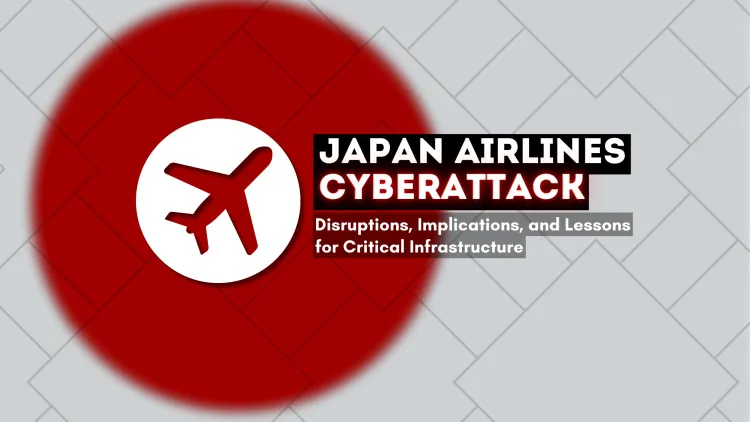Japan Airlines Cyberattack | Disruptions, Implications, and Lessons for Critical Infrastructure
Japan Airlines (JAL) faced a cyberattack on Thursday, disrupting its internal and external systems and impacting both domestic and international flights. This incident is part of a broader trend of cyberattacks targeting critical infrastructure, including a similar attack on Seattle-Tacoma International Airport earlier this year. The aviation industry must take proactive steps to safeguard against such threats, including strengthening cybersecurity frameworks, conducting regular security audits, and collaborating with governments and agencies. The attack underscores the urgent need for enhanced defenses to protect operations, passenger safety, and organizational reputation.

Cyberattacks on critical infrastructure have become increasingly common, highlighting vulnerabilities in essential systems. On Thursday morning, Japan Airlines (JAL), the nation’s second-largest airline, became the latest victim, suffering a cyberattack that disrupted both internal and external systems, affecting domestic and international flights. This incident underscores the growing risks faced by the aviation industry and critical infrastructure worldwide.
In this blog, we’ll explore the details of the cyberattack on Japan Airlines, its implications for the aviation industry, and what lessons can be drawn from this event to strengthen cybersecurity measures.

What Happened: Japan Airlines Under Cyberattack
On Thursday morning, at 7:24 am local time (2224 GMT), Japan Airlines reported a cyberattack targeting its internal and external network devices. This attack disrupted systems that communicate with external networks, affecting both domestic and international flights.
JAL issued a statement on X (formerly Twitter), confirming the attack and warning of potential disruptions to flight schedules. While acknowledging the breach, the airline’s spokesperson stated that there were no immediate updates regarding delays or cancellations.
This cyberattack is part of a rising trend targeting Japanese companies and follows several high-profile incidents affecting critical infrastructure globally.
Key Features of the Cyberattack
| Aspect | Details |
|---|---|
| Date and Time | Started on Thursday at 7:24 am local time (2224 GMT). |
| Target | Internal and external systems of Japan Airlines. |
| Impact | Disruption of communication systems, affecting both domestic and international flights. |
| Airline Response | Public acknowledgment on X; no immediate updates on delays or cancellations. |
| Broader Context | Part of a broader trend of cyberattacks targeting critical infrastructure in Japan and globally. |
Similar Cyberattacks in Recent History
The attack on Japan Airlines is not an isolated event. It follows a pattern of increasing cyber threats against critical industries, particularly in Japan and the aviation sector.
-
Toyota Supplier Attack (2022):
A cyberattack on a Toyota supplier forced the automaker to halt production at its domestic plants for an entire day, causing significant economic losses. -
Niconico Platform Attack (2023):
In June, the popular Japanese video-sharing platform Niconico suspended services following a large-scale cyberattack, disrupting millions of users. -
Seattle-Tacoma International Airport Attack (2023):
Earlier this year, Seattle-Tacoma International Airport experienced operational delays due to a "possible cyberattack", causing an internet and web systems outage.
Implications for the Aviation Industry
The aviation industry is a prime target for cybercriminals due to its reliance on interconnected systems, critical data, and the potential for widespread disruption.
1. Operational Disruptions
The attack on Japan Airlines caused system outages that could potentially lead to flight delays, cancellations, and logistical challenges for passengers and cargo.
2. Passenger Safety Concerns
Cyberattacks on airlines pose a direct risk to passenger safety if critical flight systems are compromised.
3. Financial Losses
Cyberattacks can result in substantial financial losses for airlines due to operational downtime, loss of customer trust, and regulatory penalties.
4. Damage to Reputation
Frequent cyberattacks tarnish the reputation of affected airlines, potentially leading to a decline in customer loyalty.
Lessons Learned and Preventive Measures
The cyberattack on Japan Airlines serves as a wake-up call for the aviation industry and other critical sectors to strengthen their cybersecurity measures.
1. Strengthening Cybersecurity Frameworks
Airlines must invest in robust cybersecurity frameworks, including real-time threat detection and response systems, to prevent and mitigate cyberattacks.
2. Regular Security Audits
Conducting regular penetration testing and security audits can help identify vulnerabilities in systems and ensure compliance with global security standards.
3. Employee Training
Educating employees about cyber threats, such as phishing and social engineering, is essential to minimize human error, which often serves as an entry point for attackers.
4. Incident Response Plans
Developing comprehensive incident response plans ensures quick recovery and minimizes the impact of cyberattacks.
5. Collaboration with Governments and Agencies
Airlines should collaborate with government bodies, cybersecurity agencies, and industry peers to share threat intelligence and best practices.
Conclusion
The cyberattack on Japan Airlines highlights the vulnerabilities of the aviation industry and critical infrastructure worldwide. It is a reminder that no organization is immune to cyber threats and that proactive measures are essential to safeguard operations, data, and reputation.
As cybercriminals continue to evolve their tactics, organizations must prioritize cybersecurity investments, implement robust defenses, and foster a culture of vigilance. By learning from incidents like this, the aviation industry can strengthen its resilience and ensure the safety and reliability of its services.
FAQs
-
What happened to Japan Airlines during the cyberattack?
Japan Airlines experienced a cyberattack that disrupted its internal and external systems, potentially affecting domestic and international flights. -
Was passenger data compromised in the JAL cyberattack?
As of now, there is no confirmation regarding data breaches or compromised passenger information. -
How did JAL respond to the cyberattack?
JAL acknowledged the attack on its X (formerly Twitter) account and issued warnings about potential disruptions. -
What other industries have faced similar cyberattacks?
Industries such as automotive, entertainment, and aviation have been frequent targets, including attacks on Toyota and Seattle-Tacoma International Airport. -
What are the financial implications of cyberattacks on airlines?
Cyberattacks can result in substantial financial losses due to operational downtime, customer compensation, and reputational damage. -
What lessons can be learned from the JAL cyberattack?
The incident underscores the importance of proactive cybersecurity measures, regular audits, and robust incident response plans. -
How can airlines prevent future cyberattacks?
Airlines can invest in real-time threat detection, employee training, and collaboration with cybersecurity agencies to mitigate risks. -
What role does government play in mitigating such threats?
Governments can provide resources, share intelligence, and establish regulatory frameworks to enhance cybersecurity in critical sectors. -
Were any flights canceled due to the JAL cyberattack?
As of now, there have been no confirmed cancellations, but disruptions remain a possibility. -
How does this incident affect global aviation security?
The attack emphasizes the need for global collaboration to secure aviation systems and prevent future incidents.














![Top 10 Ethical Hackers in the World [2025]](https://www.webasha.com/blog/uploads/images/202408/image_100x75_66c2f983c207b.webp)








